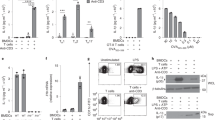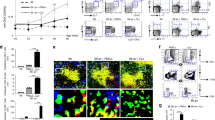Abstract
Mechanisms linking innate immunity and autoimmune responses are poorly understood1. Myeloid-related protein-8 (Mrp8) and Mrp14 are damage-associated molecular pattern molecules (DAMPs) highly upregulated in various autoimmune disorders. We show in a mouse autoimmune model that local Mrp8 and Mrp14 production is essential for the induction of autoreactive CD8+ T cells and the development of systemic autoimmunity. This effect is mediated via Toll-like receptor 4 (TLR4) signaling leading to increased interleukin-17 (IL-17) expression. Notably, expression of Mrp8 and Mrp14 was upregulated in cutaneous lupus erythematosus, and stimulation of CD8+ T cells from individuals with lupus erythematosus with MRP proteins resulted in an upregulation of IL-17, suggesting a key role for MRP8 and MRP14 for the development of autoreactive lymphocytes during human autoimmunity as well. These results demonstrate a link between local expression of DAMP molecules and the development of systemic autoimmunity.
This is a preview of subscription content, access via your institution
Access options
Subscribe to this journal
Receive 12 print issues and online access
$209.00 per year
only $17.42 per issue
Buy this article
- Purchase on Springer Link
- Instant access to full article PDF
Prices may be subject to local taxes which are calculated during checkout




Similar content being viewed by others
References
Iwasaki, A. & Medzhitov, R. Regulation of adaptive immunity by the innate immune system. Science 327, 291–295 (2010).
Grewal, I.S. & Flavell, R.A. CD40 and CD154 in cell-mediated immunity. Annu. Rev. Immunol. 16, 111–135 (1998).
Koshy, M., Berger, D. & Crow, M.K. Increased expression of CD40 ligand on systemic lupus erythematosus lymphocytes. J. Clin. Invest. 98, 826–837 (1996).
MacDonald, K.P., Nishioka, Y., Lipsky, P.E. & Thomas, R. Functional CD40 ligand is expressed by T cells in rheumatoid arthritis. J. Clin. Invest. 100, 2404–2414 (1997).
Grewal, I.S. et al. Requirement for CD40 ligand in co-stimulation induction, T cell activation, and experimental allergic encephalomyelitis. Science 273, 1864–1867 (1996).
Mehling, A. et al. Overexpression of CD40 ligand in murine epidermis results in chronic skin inflammation and systemic autoimmunity. J. Exp. Med. 194, 615–628 (2001).
Roth, J., Vogl, T., Sorg, C. & Sunderkötter, C. Phagocyte-specific S100 proteins: a novel group of proinflammatory molecules. Trends Immunol. 24, 155–158 (2003).
Foell, D. & Roth, J. Proinflammatory S100 proteins in arthritis and autoimmune disease. Arthritis Rheum. 50, 3762–3771 (2004).
van Lent, P.L. et al. Myeloid-related proteins S100A8/S100A9 regulate joint inflammation and cartilage destruction during antigen-induced arthritis. Ann. Rheum. Dis. 67, 1750–1758 (2008).
Broome, A.M., Ryan, D. & Eckert, R.L. S100 protein subcellular localization during epidermal differentiation and psoriasis. J. Histochem. Cytochem. 51, 675–685 (2003).
Foell, D. et al. Phagocyte-specific S100 proteins are released from affected mucosa and promote immune responses during inflammatory bowel disease. J. Pathol. 216, 183–192 (2008).
Ehrchen, J.M., Sunderkötter, C., Foell, D., Vogl, T. & Roth, J. The endogenous Toll-like receptor 4 agonist S100A8/S100A9 (calprotectin) as innate amplifier of infection, autoimmunity and cancer. J. Leukoc. Biol. 86, 557–566 (2009).
Vogl, T. et al. Mrp8 and Mrp14 are endogenous activators of Toll-like receptor 4, promoting lethal, endotoxin-induced shock. Nat. Med. 13, 1042–1049 (2007).
Viemann, D. et al. Myeloid-related proteins 8 and 14 induce a specific inflammatory response in human microvascular endothelial cells. Blood 105, 2955–2962 (2005).
Zenz, R. et al. Psoriasis-like skin disease and arthritis caused by inducible epidermal deletion of Jun proteins. Nature 437, 369–375 (2005).
Manitz, M.P. et al. Loss of S100A9 (MRP14) results in reduced interleukin-8–induced CD11b surface expression, a polarized microfilament system and diminished responsiveness to chemoattractants in vitro. Mol. Cell. Biol. 23, 1034–1043 (2003).
Komiyama, Y. et al. IL-17 plays an important role in the development of experimental autoimmune encephalomyelitis. J. Immunol. 177, 566–573 (2006).
Steinman, L. A brief history of TH17, the first major revision in the TH1/TH2 hypothesis of T cell–mediated tissue damage. Nat. Med. 13, 139–145 (2007).
Lee, H.J. & Sinha, A.A. Cutaneous lupus erythematosus: understanding of clinical features, genetic basis and pathobiology of disease guides therapeutic strategies. Autoimmunity 39, 433–444 (2006).
Caproni, M. et al. The CD40/CD40 ligand system in the skin of patients with subacute cutaneous lupus erythematosus. J. Rheumatol. 34, 2412–2416 (2007).
Boyd, J.H., Kan, B., Roberts, H., Wang, Y. & Walley, K.R. S100A8 and S100A9 mediate endotoxin-induced cardiomyocyte dysfunction via the receptor for advanced glycation end products. Circ. Res. 102, 1239–1246 (2008).
Zhang, F., Meng, G. & Strober, W. Interactions among the transcription factors Runx1, RORγt and Foxp3 regulate the differentiation of interleukin 17–producing T cells. Nat. Immunol. 9, 1297–1306 (2008).
Bogumil, T., Rieckmann, P., Kubuschok, B., Felgenhauer, K. & Brück, W. Serum levels of macrophage-derived protein MRP-8/14 are elevated in active multiple sclerosis. Neurosci. Lett. 247, 195–197 (1998).
Nukui, T. et al. S100A8/A9, a key mediator for positive feedback growth stimulation of normal human keratinocytes. J. Cell Biochem. 104, 453–464 (2008).
Tajima, M. et al. IL-6-dependent spontaneous proliferation is required for the induction of colitogenic IL-17–producing CD8+ T cells. J. Exp. Med. 205, 1019–1027 (2008).
Loser, K. et al. In vitro–generated regulatory T cells induced by Foxp3-retrovirus infection control murine contact allergy and systemic autoimmunity. Gene Ther. 12, 1294–1304 (2005).
Loser, K. et al. Epidermal RANKL controls regulatory T-cell numbers via activation of dendritic cells. Nat. Med. 12, 1372–1379 (2006).
Gunzer, M., Weishaupt, C., Planelles, L. & Grabbe, S. Two-step negative enrichment of CD4+ and CD8+ T cells from murine spleen via nylon wool adherence and an optimized antibody cocktail. J. Immunol. Methods 258, 55–63 (2001).
Stutte, S., Jux, B., Esser, C. & Förster, I. CD24a expression levels discriminate Langerhans cells from dermal dendritic cells in murine skin lymph nodes. J. Invest. Dermatol. 128, 1470–1475 (2008).
Acknowledgements
We would like to thank H. Hinte and C. Solé for excellent technical assistance. This work was supported by the Interdisciplinary Center of Clinical Research grant Lo2/017/07 to K.L. and S.B. as well as grant Vo2/014/09 to T.V., by the German Cancer Society grant 107891 to K.L. and S.B., by the Federal Ministry of Education and Research, project AID-Net to J.R. and by the German Research Association grant Lo817/2-1 to K.L. and S.B.
Author information
Authors and Affiliations
Contributions
K.L. conceived of the study, performed the experiments, analyzed data, prepared the figures and wrote the paper. T.V. provided recombinant Mrp8 and Mrp14 proteins as well as Mrp8- and Mrp14-specific antibodies, performed Mrp-specific ELISAs and helped to design some of the experiments. M.V., V.K. and L.K. assisted K.L. with some experiments; A.L. and D.F. provided Ager−/− mice; W.N. bred S100A9−/− mice; A.K. collected a few skin biopsies from subjects with lupus erythematosus; L.S. provided human kidney biopsies; T.A.L. provided most of the human skin biopsies and contributed advice in parts of the study; J.R. provided expertise and helped to design experiments and to write the paper; S.B. contributed expertise and helped to write the paper.
Corresponding author
Ethics declarations
Competing interests
The authors declare no competing financial interests.
Supplementary information
Supplementary Text and Figures
Supplementary Data, Supplementary Methods and Supplementary Figures 1 and 2 (PDF 667 kb)
Rights and permissions
About this article
Cite this article
Loser, K., Vogl, T., Voskort, M. et al. The Toll-like receptor 4 ligands Mrp8 and Mrp14 are crucial in the development of autoreactive CD8+ T cells. Nat Med 16, 713–717 (2010). https://doi.org/10.1038/nm.2150
Received:
Accepted:
Published:
Issue Date:
DOI: https://doi.org/10.1038/nm.2150
This article is cited by
-
Generation of a novel monoclonal antibody against inflammatory biomarker S100A8 using hybridoma technology
Biotechnology Letters (2023)
-
Role of alarmins in poststroke inflammation and neuronal repair
Seminars in Immunopathology (2023)
-
Hepatic non-parenchymal S100A9-TLR4-mTORC1 axis normalizes diabetic ketogenesis
Nature Communications (2022)
-
The associations of serum S100A9 with the severity and prognosis in patients with community-acquired pneumonia: a prospective cohort study
BMC Infectious Diseases (2021)
-
Clinical parameters and biological markers associated with acute severe ocular complications in Stevens-Johnson syndrome and toxic epidermal necrolysis
Scientific Reports (2021)



